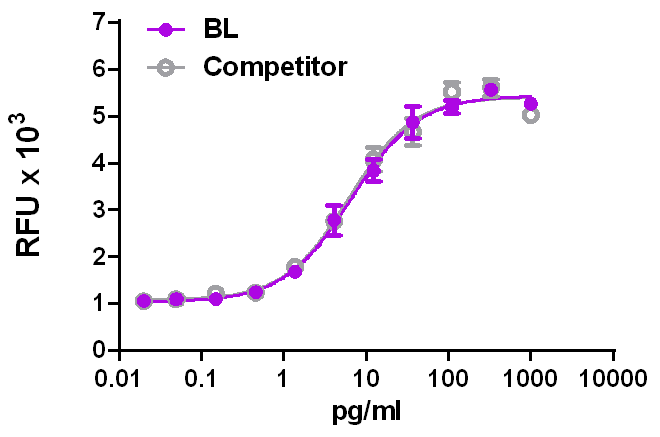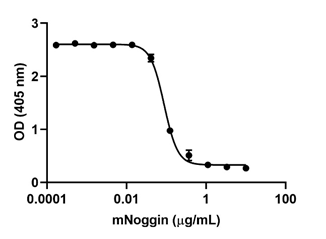- Regulatory Status
- RUO
- Other Names
- Fibroblast Growth Factor-10, FGF10, Keratinocyte growth factor 2, KGF-2, KGF2
- Ave. Rating
- Submit a Review
- Product Citations
- publications

-

Mouse FGF-10 induces MCF-7 cell proliferation in the presence of 2 μg/mL of heparin, in a dose-dependent manner. Proliferation was measured by the colormetric MTS assay. BioLegend’s mouse FGF-10 product was compared side-by-side to a competitor’s equivalent product.
FGF-10 is a member of the fibroblast growth factor family and belongs to the FGF-7 subfamily. The mitogenic activity of FGF-10 is similar to that of FGF-7. It has no mitogenic activity for NIH/3T3 cells. FGF-10 acts as a paracrine growth factor and plays multiple roles in organogenesis. FGF-10 is essential for embryonic lung branching morphogenesis. During embryonic lung development, FGF-10 is expressed in the distal mesenchyme and acts on the distal lung epithelial progenitors to prevent them from differentiating into proximal epithelial cells by inducing Sox9 and repressing Sox2 expression. FGF-10 knockout mice die at birth due to its lack of lung and limb formation. FGF-10 takes an important role in adult lung repair and its regulation is critical for the amplification of epithelial progenitors. FGF-10 also controls adipocyte differentiation by inhibiting C/EBPβ. The development of embryonic white adipocyte tissue of FGF-10 knockout mice is greatly impaired. Additionally, FGF-10 participates in the development of pancreas, stomach, skin, hair follicle, and wound healing as well. The increased expression of FGF-10 and the receptor FGFR2-IIIb are associated with several diseases such as prostate, breast, pancreas, and colorectal cancer, which suggests a role of FGF-10 in carcinogenesis.
Product DetailsProduct Details
- Source
- Mouse FGF-10, amino acids (Ser62-Thr209) (Accession# BC048229) with an N-terminus Met, was expressed in E. coli.
- Molecular Mass
- The 149 amino acid recombinant protein has a predicted molecular mass of approximately 17.1 kD. The protein migrates approximately at 17 kD in DTT-reducing and non-reducing conditions by SDS-PAGE. The predicted N-terminal amino acid is Met.
- Purity
- >95%, as determined by Coomassie stained SDS-PAGE.
- Formulation
- 20 mM MOPS in pH 7.2, 150 mM Na2SO4, 0.2 mM EDTA, 2 mM DTT, and in 10% glycerol.
- Endotoxin Level
- Less than 0.01 ng per µg cytokine as determined by the LAL method.
- Concentration
- 10 and 25 µg sizes are bottled at 200 µg/mL. 100 µg size and larger sizes are lot-specific and bottled at the concentration indicated on the vial. To obtain lot-specific concentration and expiration, please enter the lot number in our Certificate of Analysis online tool.
- Storage & Handling
- Unopened vial can be stored between 2°C and 8°C for up to 2 weeks, at -20°C for up to six months, or at -70°C or colder until the expiration date. For maximum results, quick spin vial prior to opening. The protein can be aliquoted and stored at -20°C or colder. Stock solutions can also be prepared at 50 - 100 µg/mL in appropriate sterile buffer, carrier protein such as 0.2 - 1% BSA or HSA can be added when preparing the stock solution. Aliquots can be stored between 2°C and 8°C for up to one week and stored at -20°C or colder for up to 3 months. Avoid repeated freeze/thaw cycles.
- Activity
- The ED50 = 0.2 - 1.0 ng/ml, corresponding to a specific activity of 1.0 - 5.0 x 106 units/mg, as determined by a dose-dependent stimulation of MCF-7 cell proliferation in the presence of 2 µg/ml heparin.
- Application
-
Bioassay
- Application Notes
-
BioLegend carrier-free recombinant proteins provided in liquid format are shipped on blue-ice. Our comparison testing data indicates that when handled and stored as recommended, the liquid format has equal or better stability and shelf-life compared to commercially available lyophilized proteins after reconstitution. Our liquid proteins are verified in-house to maintain activity after shipping on blue ice and are backed by our 100% satisfaction guarantee. If you have any concerns, contact us at tech@biolegend.com.
Antigen Details
- Structure
- Growth factor.
- Distribution
-
FGF-10 is expressed and secreted by the mesenchyme fibroblasts during embryonic development. It is secreted by 3T3L1 preadipocytes.
- Function
- FGF-10 is an epithelial-mesenchymal signaling molecule and plays imporant roles in multi-organ development. Its expression is regulated by Wnt signaling, Pax9, and c0Myc.
- Interaction
- FGF-10 targets urothelial cells, epithelial cells, epidermal cells, keratinocyte, and smooth muscle scells. FGF-10 interacts with FGFBP1.
- Ligand/Receptor
- FGFR2-IIIb.
- Cell Type
- Embryonic Stem Cells, Hematopoietic stem and progenitors, Mesenchymal Stem Cells, Neural Stem Cells
- Biology Area
- Cell Biology, Neuroscience, Stem Cells, Synaptic Biology
- Molecular Family
- Cytokines/Chemokines, Growth Factors
- Antigen References
-
1. Sekine K, et al. 1999. Nat. Genet. 21:138.
2. Petiot A, et al. 2003. Development 130:5493.
3. Tagashira S, et al. 1997. Gene 197:390.
4. El Agha E adn Bullusci S. 2014. Scientifica 2014:53879.
5. Ramasamy SK, et al. 2007. Dev. Biol. 307:237.
6. Yamasaki M, et al. 1999. Biochem Biphys Res Commun 258:109.
7. Emoto H, et al. 1997. J. Biol. Chem. 272:23191. - Gene ID
- 14165 View all products for this Gene ID
- UniProt
- View information about FGF-10 on UniProt.org
Related FAQs
- Why choose BioLegend recombinant proteins?
-
• Each lot of product is quality-tested for bioactivity as indicated on the data sheet.
• Greater than 95% Purity or higher, tested on every lot of product.
• 100% Satisfaction Guarantee for quality performance, stability, and consistency.
• Ready-to-use liquid format saves time and reduces challenges associated with reconstitution.
• Bulk and customization available. Contact us.
• Learn more about our Recombinant Proteins. - How does the activity of your recombinant proteins compare to competitors?
-
We quality control each and every lot of recombinant protein. Not only do we check its bioactivity, but we also compare it against other commercially available recombinant proteins. We make sure each recombinant protein’s activity is at least as good as or better than the competition’s. In order to provide you with the best possible product, we ensure that our testing process is rigorous and thorough. If you’re curious and eager to make the switch to BioLegend recombinants, contact your sales representative today!
- What is the specific activity or ED50 of my recombinant protein?
-
The specific activity range of the protein is indicated on the product datasheets. Because the exact activity values on a per unit basis can largely fluctuate depending on a number of factors, including the nature of the assay, cell density, age of cells/passage number, culture media used, and end user technique, the specific activity is best defined as a range and we guarantee the specific activity of all our lots will be within the range indicated on the datasheet. Please note this only applies to recombinants labeled for use in bioassays. ELISA standard recombinant proteins are not recommended for bioassay usage as they are not tested for these applications.
- Have your recombinants been tested for stability?
-
Our testing shows that the recombinant proteins are able to withstand room temperature for a week without losing activity. In addition the recombinant proteins were also found to withstand four cycles of freeze and thaw without losing activity.
- Does specific activity of a recombinant protein vary between lots?
-
Specific activity will vary for each lot and for the type of experiment that is done to validate it, but all passed lots will have activity within the established ED50 range for the product and we guarantee that our products will have lot-to-lot consistency. Please conduct an experiment-specific validation to find the optimal ED50 for your system.
- How do you convert activity as an ED50 in ng/ml to a specific activity in Units/mg?
-
Use formula Specific activity (Units/mg) = 10^6/ ED50 (ng/mL)
 Login / Register
Login / Register 






_Mouse_RECOM_CA_BA_070115.JPG)





Follow Us